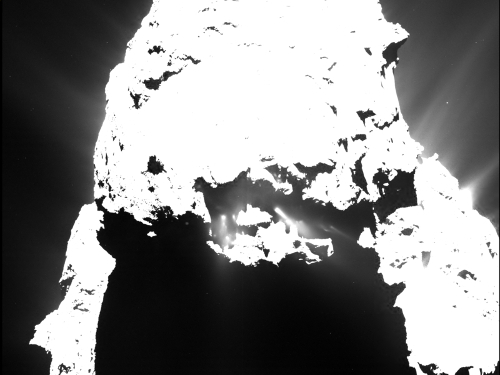The Planetary Society’s Emily Lakdawalla tells us (via Twitter) that she has a history with jigsaw puzzles, one that finally paid off in the image below. You’re looking at her work on a partially de-scrambled image from LightSail, fragmentary because the entire image was not downloaded during a Cal Poly (San Luis Obispo) overflight on the afternoon of the 8th. The complete image should be downloaded later today, and perhaps shown at an upcoming press conference with LightSail engineering team leaders scheduled for Wednesday June 10 at 1730 UTC (1330 EDT).

At any rate, LightSail’s deployed sails are in view. Bill Nye, CEO of The Planetary Society, was on National Public Radio yesterday (audio here) in a brief spot in which he described the unfurling of the solar sail as a ‘sail Mary pass,’ a longshot required by circumstance as the spacecraft continued to tumble. If the phrase ‘sail Mary pass’ is inscrutable to you, you may not be familiar with American football, where ‘hail Mary pass’ has become a routine way of describing desperate plays made under pressure (this exhausts my knowledge of football — I know only baseball — and I will send you to the Wikipedia for details). At any rate, sail deployment was the purpose of this first LightSail mission, and sail deployment we had [although I’m now hearing we have only ‘partial’ deployment – stay tuned].
Ceres in Motion
Meanwhile, spectacular views from ongoing space missions continue to flow in. The next few weeks in particular are going to be rich in imagery as New Horizons closes on Pluto/Charon and Dawn continues its work at Ceres. The latest video animation from Ceres is something to enjoy more than once with a cup of coffee. If this doesn’t start your day right, what will?
Eighty images were combined to create the video, with the vertical dimension exaggerated by a factor of two. The views are from Dawn’s first mapping orbit at 13,600 kilometers and include later navigation images from 5100 kilometers, providing a detailed view of the terrain. I’m using the copy of the JPL video that io9 kindly posted to YouTube.
Dawn’s second mapping orbit began on June 3, with the rest of the month slated for observations about 4400 kilometers above the surface. Of the video, Dawn team member Ralf Jaumann (DLR, Berlin) says: “We used a three-dimensional terrain model that we had produced based on the images acquired so far. They will become increasingly detailed as the mission progresses — with each additional orbit bringing us closer to the surface.”
A Restive Comet
The Ma’at region at comet 67P/Churyumov-Gerasimenko’s ‘head’ clearly stays active even after it falls into shadow, as we can see from the latest imagery from the Rosetta spacecraft. Here we’re looking at jets of dust escaping into space, the result, researchers believe, of the increased heating of the comet as it moves closer to the Sun. Perihelion is coming up in mid-August, and this image was taken with a scant 270 million kilometers separating Sun and comet. “Only recently have we begun to observe dust jets persisting even after sunset”, says OSIRIS principal investigator Holger Sierks (Max Planck Institute for Solar System Research).

Image: This image of Rosetta’s comet taken on 25 April, 2015 from a distance of approximately 93 kilometers shows clearly distinguishable jets of dust after nightfall. Credit: ESA/Rosetta/MPS for OSIRIS Team MPS/UPD/LAM/IAA/SSO/INTA/UPM/DASP/IDA.
OSIRIS scientist Xian Shi (MPS) adds that although the dusty cometary surface cools rapidly after sunset, deeper layers of the comet — evidently containing frozen gases — retain their heat, a phenomenon that has also been observed on comet 81P/Wild 2 and Deep Impact comet 9P/Tempel 1. We’ll learn a good deal more about how comets awaken as Rosetta follows 67P/Churyumov-Gerasimenko into the summer in the long fall toward perihelion.



Re: Ceres. In the lass images of the video, it appears we are seeing paler material looking like ejecta on the surface around the impact craters. Is this real, a trick of the light or even an artifact of the image processing? Some of that lighter material even appears to form the scarp faces of the craters. Any possibility this contains ice from below the surface?
That is a great shot of the sail. But you know that looks like it would
make a great book cover. In our story This is the view from the bridge as your interstellar vessel prepares to plunge into a solar corona to [ fill in engine specs ] to refuel and be on next journey. reminds of looking out of a super tanker.
I don’t know what I would do without your blog, Paul. I catch almost all of my space updates here. Thanks for the great work!
Very exciting times for planetary exploration- I like the close look at Ceres! I’m fascinated by that particular planetoid. And I eagerly await the Pluto flyby.
Good to see the sail unfurled on Lightsail. I was worried for a bit there. :-)
Rob, I’ve been picturing that very thing while listening to Al Stewart’s “Lord Grenville” and “Beautiful World” by DEVO. For those unfamiliar with American football, Googling Andy Griffith’s classic story “What It Was, Was Football” will explain the intricacies of the game. Also (regarding the apparent partial deployment of the solar sail):
Might a hybrid between the structure-less spin-rigidized sails and the boom-supported sails be the best compromise overall? Spinning sails are lighter, but have to be kept spinning (even when station-keeping or in a parking orbit), while boom-supported sails are heavier and are subject to partial deployments and/or fouling during deployment. But:
A spin-deployed sail with lightweight structural members might be the best of both worlds. Its deployment should be easier and more certain, its structural support members could be lighter than those of a non-spinning sail (because the centrifugal force would [1] help to keep the sail rigid, and [2] it would allow the supporting booms to function as tension members, so that they could be lighter), yet the sail could still remain extended–if more flexible–even if its spin slowed or stopped altogether. (The pressure-stabilized propellant tanks of SpaceX’s Falcon rockets are similar in concept, employing both adequate stiffness [when un-pressurized] to be handled when empty, which when combined with internal pressure makes the tanks strong enough to handle the in-flight loads.)
J. Jason Wentworth – If you spin deploy and maintain, how would you handle the instrument platform? De-spin from the sails requiring a rotating coupling, or let the platform spin and use software to “de-spin” the I/O?
Depending on the sail, I like the idea of spin deployment, but then de-spinning the vehicle after sail deployment.
I wonder if some sort of inflating boom structure that emulates the way insect wings are inflated after emerging from their chrysalis might offer advantages, especially if some of the “veins” could be discarded after they have served their purpose?
Spinning sails (such as IKAROS and the old disc sail designs) just keep/kept spinning. Moving the centrally-located spacecraft bus off-center on rails (or by reeling in cables), or changing the sail’s reflectivity at the same point during each rotation (as IKAROS did with its “variable albedo” LCD panels), generates torques for changing the sail’s orientation. Also:
Very lightweight spin-deployed inflatable booms, which could be impregnated with a resin that hardens in a vacuum, could enable a sail to retain its shape, if limply, even with little or no spin. This feature would make such sails easier to load and unload (of cargo) and make them easier to service in space.
Rosetta’s little lander Philae radios back to Earth!
http://www.americaspace.com/?p=83177
More details on Philae, though it has not been heard from since that exciting contact this morning:
http://news.sciencemag.org/europe/2015/06/scientists-celebrate-comet-lander-philae-s-call-after-7-month-slumber
@ J. Jason Wentworth
IIRC LightsailA’s sail was designed to partially deploy (around 90%) at first to avoid tearing if the tape-booms over-extended in the eventuality that their motor rotation counts got out of sync. As in the pre-launch table-top unfurling, Lightsail’s booms would partially extend and then be incrementally extended out to 100%. The Planetary Society was prevented from doing this final 100% extending to tighten the sail when the poor cubesats radio went nuts, thereby calling things a little short.
Can’t wait until LightsailB.